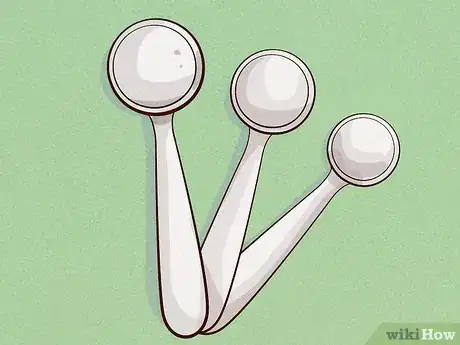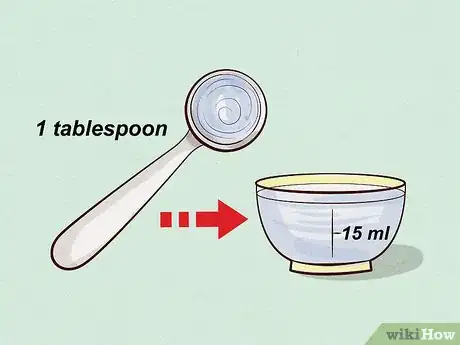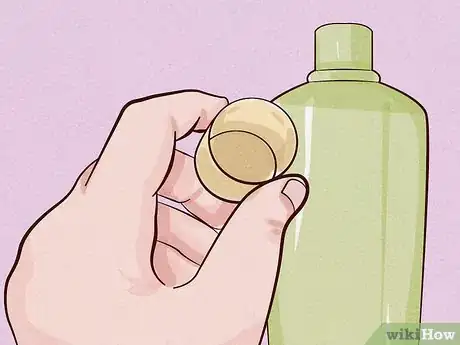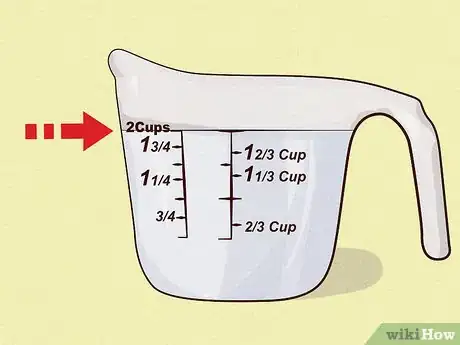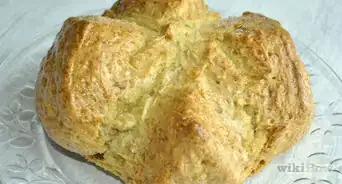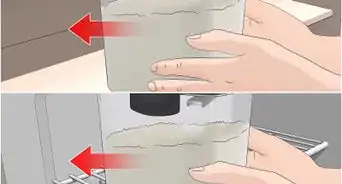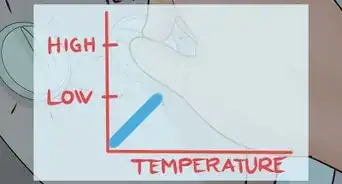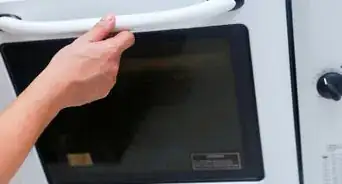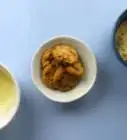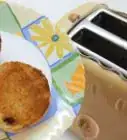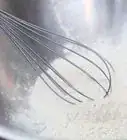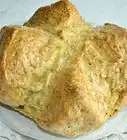This article was co-authored by wikiHow Staff. Our trained team of editors and researchers validate articles for accuracy and comprehensiveness. wikiHow's Content Management Team carefully monitors the work from our editorial staff to ensure that each article is backed by trusted research and meets our high quality standards.
This article has been viewed 386,378 times.
Learn more...
The simplest way to measure a tablespoon is to use a measuring spoon. If you don't have one, you can get the same amount using its equivalent in other units of measure. If you don't have any measuring tools with you, use object comparisons as references to portion out approximately the same portion as a tablespoon.
Steps
Finding Measurement Equivalents
-
1Use 3 level teaspoons to make a tablespoon. Remembering measurement equivalents is a great way to speed up cooking time in the kitchen. The most simple conversion is tablespoons to teaspoons. If you are missing a tablespoon, simply measure out three level teaspoons instead.[1]
-
2Measure 1/16 of a cup. A tablespoon is equivalent to 1/16 of a cup, which will allow you to easily measure out that amount without a measuring spoon. Given this small portion, it is easiest to measure out 1/16 in a large, clearly-marked measuring cup. Otherwise, it would be best to approximate one tablespoon using half of an 1/8 cup, the smallest measuring cup in a set.[2]Advertisement
-
3Pour out 15 ml of any liquid to equal 1 tablespoon. For fast conversions, remember that 15 ml of a liquid is the equivalent of 1 tablespoon. This means that there will be between 16 and 17 tablespoons in a common 250 ml serving of liquids, which equals 1 cup. Be sure that all measurements are level to ensure even conversions.[3]
-
4Use bottle caps to measure a tablespoon of liquid. Some bottles will purposefully hold a single tablespoon, making it easy to portion out that amount while cooking or baking. This may apply to oil, flavor extracts, and other similar ingredients. Measure how much your bottle caps hold when you first purchase a new cooking ingredient to have the conversions in mind in the future.[4]
Using Object Comparisons
-
1Remember that 2 tablespoons is the size of a ping pong ball. If you want to monitor your portion sizes when eating at restaurants, knowing how to visually identify a tablespoon is a valuable skill. As a reference, keep in mind that a ping pong ball generally represents two tablespoons. While this may be difficult to identify with liquids, solid substances will make the comparison pretty straightforward.[5]
-
2Use the tip of your thumb as a guide for measuring a tablespoon. As a general rule, the tip of your finger should measure about 1 teaspoon while the tip of your thumb should equal about a tablespoon. Hold your thumb next to whatever you are measuring to portion out a similar amount. Adjust the amount slightly if you thumb is larger or smaller than average.[6]
-
3Use a cupped hand to measure 2 tablespoons of liquid. As a general rule, a cupped hand will hold about 2 tablespoons of liquid. If you do not have any measuring spoons or cups, you can approximate a tablespoon of liquid by filling up your cupped hand halfway. If your hands are especially small or large, you may add or omit liquid accordingly.[7]
-
4Note the portions of food that always equal a tablespoon. Some foods have consistent portion sizes and can be broken down to a tablespoon easily. Keep these in mind for fast measuring the next time you are cooking, baking, or calorie counting. One tablespoon of sugar, for instance, is equal to 3 single serving packets of sugar, or 3 sugar cubes.[8]
- As another example, a stick of butter is 8 tablespoons, so 1/8 of a stick of butter always equals a single tablespoon.
Community Q&A
-
QuestionShould I use a level or a heaped tablespoon?
 Community AnswerA level spoon is generally recommended unless your recipe specifies otherwise.
Community AnswerA level spoon is generally recommended unless your recipe specifies otherwise. -
QuestionWhat do T, tb, tbs, and tbsp stand for?
 Community AnswerAll of these are common abbreviations for "tablespoon." Be sure to read carefully, however, as "t" and "tsp" stand for teaspoon, a much smaller measurement!
Community AnswerAll of these are common abbreviations for "tablespoon." Be sure to read carefully, however, as "t" and "tsp" stand for teaspoon, a much smaller measurement! -
QuestionWhat is 12.5 ml compared to a teaspoon?
 Community AnswerOne teaspoon = 5 ml, so 12.5 ml = 2 1/2 teaspoons, or nearly a tablespoon.
Community AnswerOne teaspoon = 5 ml, so 12.5 ml = 2 1/2 teaspoons, or nearly a tablespoon.
References
- ↑ http://www.hintsandthings.co.uk/kitchen/measures.htm
- ↑ http://www.goodcooking.com/conversions/liq_dry.htm
- ↑ http://www.hintsandthings.co.uk/kitchen/measures.htm
- ↑ https://www.leaf.tv/articles/how-to-approximate-a-teaspoon/
- ↑ https://my.clevelandclinic.org/health/articles/9436-meals-making-sense-of-portion-sizes
- ↑ https://my.clevelandclinic.org/health/articles/9436-meals-making-sense-of-portion-sizes
- ↑ https://my.clevelandclinic.org/health/articles/9436-meals-making-sense-of-portion-sizes
- ↑ https://www.today.com/health/ah-sugar-sugar-quit-your-sweetness-addiction-2D80555506
About This Article
The most accurate way to measure a tablespoon is to use a measuring spoon. If you don't have a measuring spoon, you can use measurement equivalents. For example, 3 level teaspoons makes 1 tablespoon. 1/16 of a cup is also equivalent to 1 tablespoon, and 15 ml of any liquid is equal to 1 tablespoon. If you don't have any measuring tools, try eyeballing it to estimate. 2 tablespoons of a dry ingredient will be approximately the size of a ping pong ball, and 2 tablespoons of liquid will fill a cupped hand. If you want to learn how to use bottle caps to measure out tablespoons, keep reading the article!
